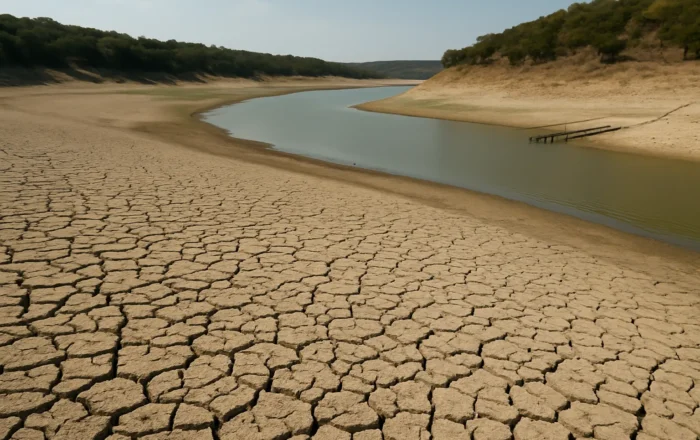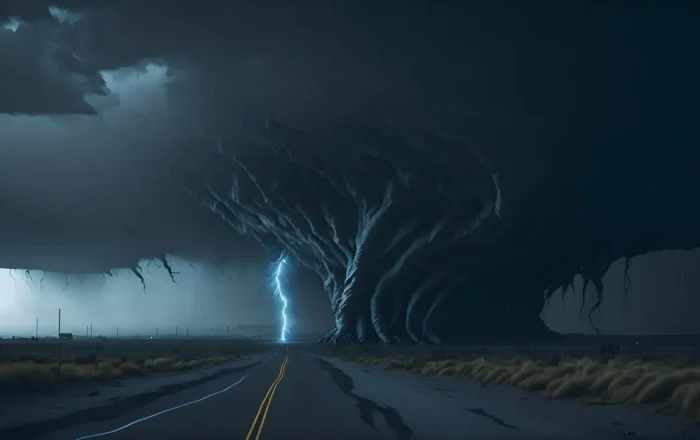Is Texas Still in a Drought?
4 minute readTexas has faced decades of drought cycles, but is the state still in a drought today?
Home > BKV Energy Blog > All Posts > What Causes Floods in Texas?
Flooding in Texas is driven by heavy rain, hurricanes, rivers, and rapid urban growth, making it one of the most flood-prone states in the nation.
4 minute read • Last update September 2025

The main causes of flooding in Texas are:
Texas is known for its extremes, from scorching summers to powerful thunderstorms, and flooding is one of the most persistent and costly hazards the state faces. Thanks to its varied climate and rapid urban growth, nearly every region of Texas has experienced flood disasters, whether from hurricanes along the Gulf Coast, sudden flash floods in the Hill Country, or river overflows that impact rural and urban areas alike.
Flooding is not only frequent, it is also diverse in its causes. A storm that drops several inches of rain in just a few hours can lead to dangerous flash floods, while a slow-moving hurricane can bring days of rainfall and widespread devastation. River systems, reservoirs, and drainage infrastructure add more complexity, and changing climate patterns are intensifying risks even further.
Texas is no stranger to sudden, intense downpours. When rain falls faster than the ground can absorb it, flash floods in Texas occur. These floods develop quickly, sometimes within minutes, leaving little time for warning or evacuation.
The Hill Country and Central Texas are especially vulnerable due to rocky terrain and shallow soils that do not absorb water easily. This area is part of what meteorologists call Flash Flood Alley, one of the most flood-prone regions in the country.
Along the Gulf Coast, hurricanes and tropical storms are a major source of flooding. These systems bring torrential rainfall, storm surge, and widespread inland flooding. For example, Hurricane Harvey in 2017 dropped more than 50 inches of rain in parts of Southeast Texas, causing record-breaking flood damage.
This combination of heavy rain and coastal surge makes hurricane flooding in Texas especially devastating for both coastal communities and inland cities connected by river systems.
Texas is home to major rivers, including the Brazos, Trinity, and Colorado, which can quickly rise and overflow their banks after prolonged rainfall. When rivers flood, the damage often spreads across vast areas, impacting both rural farmland and densely populated cities.
Reservoirs and dams are designed to manage these water flows, but during extreme weather, even these systems can contribute to flooding. Controlled water releases may be necessary to prevent dam failure, leading to downstream flooding and increased Texas dam flood risk.
Flood risks in cities are often worsened by rapid urban growth. Paved surfaces like roads, parking lots, and rooftops prevent water from soaking into the ground, funneling rainfall into storm drains and bayous.
Cities such as Houston, Dallas, and Austin have struggled with urban flooding in Texas because drainage systems were not built to handle today’s rapid population growth and increasingly severe storms. As a result, neighborhoods can flood even during moderate rain events.
Texas has one of the highest flood risks in the nation due to a unique mix of climate, geography, and development patterns. The state is vast, with climates ranging from arid deserts to humid coastlines. This diversity creates a constant threat of flooding, from coastal surges to inland flash floods.
Additionally, Texas’s rapid population growth means more people live in flood-prone areas. According to the Texas flooding map, many counties are at high or moderate flood risk, and expanding development often increases exposure. Simply put, Texas flood risk is a combination of natural factors and human impact.
Flood risk in Texas is shaped not only by storms and rainfall but also by the state’s geography and seasonal weather patterns. Different regions face distinct threats based on terrain, soil conditions, proximity to rivers, and exposure to the Gulf of Mexico.
Steep hillsides and thin soils in Central Texas create ideal conditions for flash floods, while flat coastal plains are highly vulnerable to storm surge and heavy rain from hurricanes. North and Central Texas often experience severe thunderstorms tied to spring and early summer weather systems.
Understanding these regional and seasonal differences helps explain why flooding can look very different depending on where you live in the state.
The Texas Hill Country is infamous for its steep terrain and rocky soil. Water runs off slopes quickly, turning small creeks into raging rivers. That is why this region is often called Flash Flood Alley, as storms can unleash dangerous floods within hours.
The Gulf Coast is exposed to tropical storms, hurricanes, and storm surge. Texas coastal flooding is most common during hurricane season, which runs from June through November, with a peak in late summer. Even outside hurricane events, the region’s flat topography makes it susceptible to year-round flooding.
Seasonal thunderstorms and tornado-related weather systems bring heavy rain to North and Central Texas. The Dallas–Fort Worth metroplex, for example, has experienced numerous flood events tied to spring and summer storm systems. May and June are typically the stormiest parts of the year for Texas, and storms like these are to be expected. These peak storm months often coincide with flash flooding events that can overwhelm creeks, rivers, and urban drainage systems.
Temperature changes are amplifying Texas’ flood risks. Warmer air holds more moisture, leading to heavier downpours. This means storms that once produced moderate flooding now generate catastrophic events.
On the coast, rising sea levels increase the reach of storm surge, putting more communities at risk. Projections suggest that climate change and Texas floods will make future flood events more frequent and severe, compounding the state’s future flood risk in Texas.
Here is a look at notable flood events that illustrate the range of risks across the state:
| Year | Event | Primary Cause | Impact |
|---|---|---|---|
| 1921 | Central Texas Floods | Remnants of a hurricane | Over 200 fatalities |
| 1935 | Austin Flood | River flooding of the Colorado River | Destroyed homes, led to dam projects |
| 1957 | Hill Country Floods | Flash flooding after heavy rain | Hundreds displaced |
| 2015 | Memorial Day Floods | Torrential rain, river overflow | $3B in damages |
| 2017 | Hurricane Harvey | Coastal storm surge and rainfall | $125B in damages |
| 2022 | Dallas Flash Floods | Overnight downpour | Billions in insured losses |
Flooding cannot always be avoided, but preparation helps reduce risk. Homeowners in flood-prone areas benefit from carrying flood insurance, keeping emergency supplies readily available, and being familiar with local evacuation routes. Flood recovery is just as critical, taking into account safety measures, cleanup considerations, and how to navigate the aftermath once the waters recede. It is also important to understand the difference in flash flood watch and warning alerts issued by the National Weather Service.
Flooding is only one of the natural challenges Texans face. From drought conditions to tornado risks, understanding the state’s climate helps residents make informed decisions about safety and energy use. Explore more resources on our blog to stay prepared and informed.
Graham Lumley, Digital Marketing Manager at BKV Energy, leads digital and traditional marketing strategies, focusing on educating Texans about the state's deregulated energy market. With over 8 years of marketing experience, he creates content to help consumers understand and save on their energy bills, bringing a fresh and dynamic approach to the industry.

Texas has faced decades of drought cycles, but is the state still in a drought today?

Discover where tornadoes strike most often in Texas and how to stay safe.
Get $50 off your electric bill!
Use code BKVEJOINUS50
Enter your zip code to shop BKV Energy's affordable, fixed-rate Texas electricity plans. Use the promo code for $50 off your electric bill.